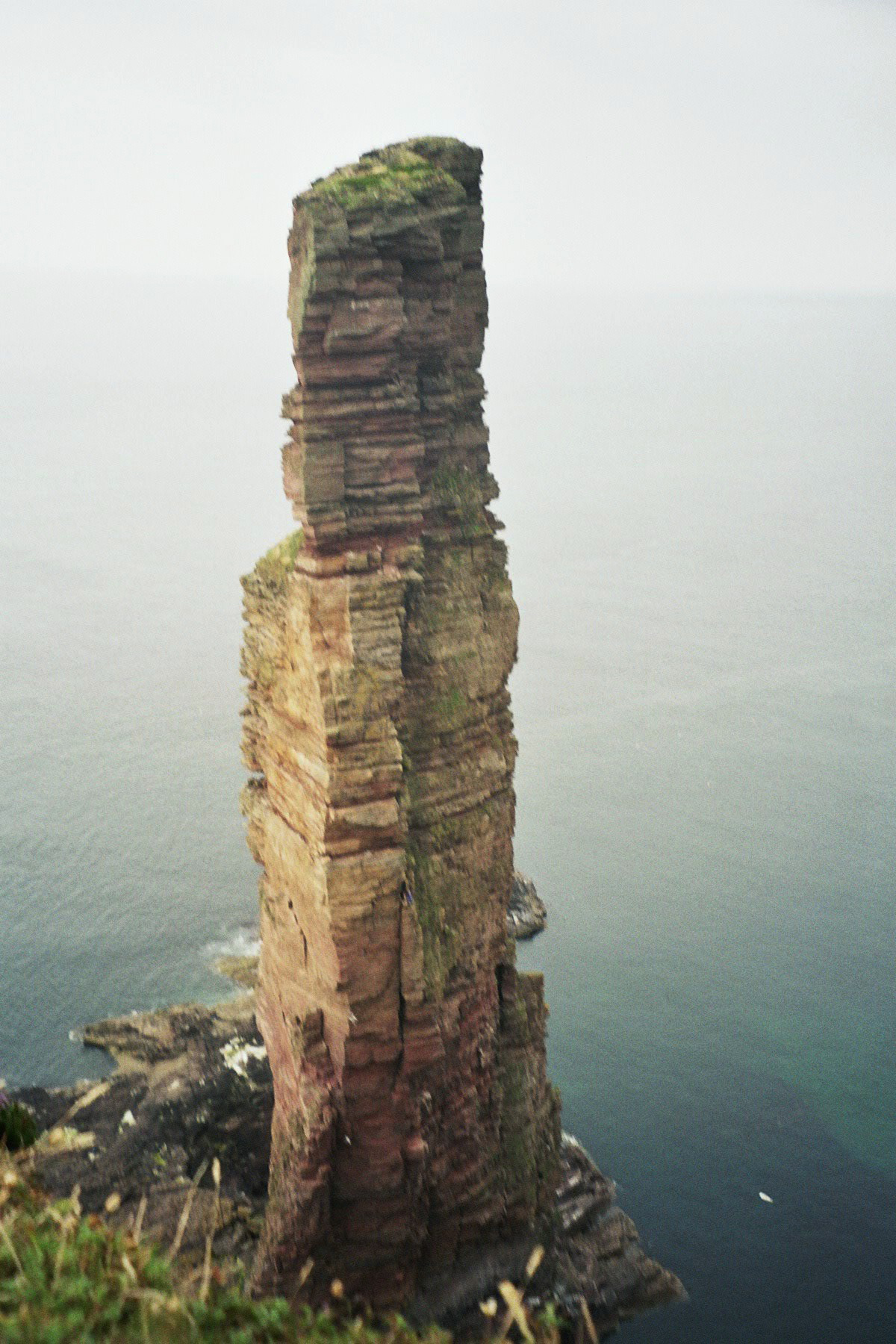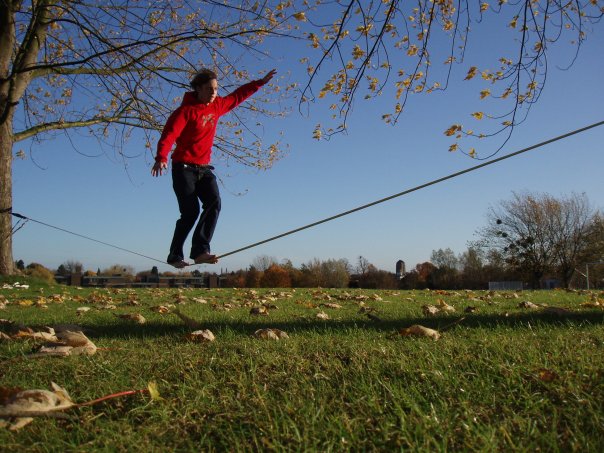|
The Old Man Of Hoy
The Old Man of Hoy is a sea stack on Hoy, part of the Orkney archipelago off the north coast of Scotland. Formed from Old Red Sandstone, it is one of the tallest stacks in the United Kingdom. The Old Man is popular with climbers, and was first climbed in 1966. Created by the erosion of a cliff through hydraulic action some time after 1750, the stack is not more than a few hundred years old, but may soon collapse into the sea. Geography The Old Man stands close to Rackwick Bay on the west coast of Hoy, in Orkney, Scotland, and can be seen from the Scrabster to Stromness ferry. From certain angles it is said to resemble a human figure. Winds are faster than for nearly a third of the time, and gales occur on average for 29 days a year. Combined with the depth of the sea, which quickly falls to , high-energy waves on the western side of Hoy lead to rapid erosion of the coast. Geology The Old Man of Hoy is a red sandstone stack, perched on a plinth of basalt rock, and one of the t ... [...More Info...] [...Related Items...] OR: [Wikipedia] [Google] [Baidu] |
Orkney
Orkney (; sco, Orkney; on, Orkneyjar; nrn, Orknøjar), also known as the Orkney Islands, is an archipelago in the Northern Isles of Scotland, situated off the north coast of the island of Great Britain. Orkney is 10 miles (16 km) north of the coast of Caithness and has about 70 islands, of which 20 are inhabited. The largest island, the Mainland, Orkney, Mainland, has an area of , making it the List of islands of Scotland, sixth-largest Scottish island and the List of islands of the British Isles, tenth-largest island in the British Isles. Orkney’s largest settlement, and also its administrative centre, is Kirkwall. Orkney is one of the 32 Subdivisions of Scotland, council areas of Scotland, as well as a Orkney (Scottish Parliament constituency), constituency of the Scottish Parliament, a Lieutenancy areas of Scotland, lieutenancy area, and an counties of Scotland, historic county. The local council is Orkney Islands Council, one of only three councils in Scotland with ... [...More Info...] [...Related Items...] OR: [Wikipedia] [Google] [Baidu] |
Cairn
A cairn is a man-made pile (or stack) of stones raised for a purpose, usually as a marker or as a burial mound. The word ''cairn'' comes from the gd, càrn (plural ). Cairns have been and are used for a broad variety of purposes. In prehistoric times, they were raised as markers, as memorials and as burial monuments (some of which contained chambers). In modern times, cairns are often raised as landmarks, especially to mark the summits of mountains. Cairns are also used as trail markers. They vary in size from small stone markers to entire artificial hills, and in complexity from loose conical rock piles to elaborate megalithic structures. Cairns may be painted or otherwise decorated, whether for increased visibility or for religious reasons. A variant is the inuksuk (plural inuksuit), used by the Inuit and other peoples of the Arctic region of North America. History Europe The building of cairns for various purposes goes back into prehistory in Eurasia, ranging in s ... [...More Info...] [...Related Items...] OR: [Wikipedia] [Google] [Baidu] |
Tupperware
Tupperware is an American home products line that includes preparation, storage, and serving products for the kitchen and home. In 1942, Earl Tupper developed his first bell-shaped container; the brand products were introduced to the public in 1946. Tupperware develops, manufactures, and internationally distributes its products as a wholly owned subsidiary of its parent company Tupperware Brands; as of 2007, it was sold by means of approximately 1.9 million direct salespeople on contract. In 2013, the top marketplace for Tupperware was Indonesia, which topped Germany as the second. Indonesia's sales in 2013 were more than $200 million. Company history Tupperware was developed in 1946 by Earl Tupper (1907-1983) in Leominster, Massachusetts. He developed plastic containers to be used in households to contain food and keep them airtight, which featured a then-patented "burping seal". Tupper had already invented the plastic for Tupperware in 1938, but the product succeeded with th ... [...More Info...] [...Related Items...] OR: [Wikipedia] [Google] [Baidu] |
Grade (climbing)
In rock climbing, mountaineering, and other climbing disciplines, climbers give a grade to a climbing route or boulder problem, intended to describe concisely the difficulty and danger of climbing it. Different types of climbing (such as sport climbing, bouldering or ice climbing) each have their own grading systems, and many nationalities developed their own, distinctive grading systems. There are a number of factors that contribute to the difficulty of a climb, including the technical difficulty of the moves, the strength, stamina and level of commitment required, and the difficulty of protecting the climber. Different grading systems consider these factors in different ways, so no two grading systems have an exact one-to-one correspondence. Climbing grades are inherently subjective.Reynolds Sagar, Heather, 2007, ''Climbing your best: training to maximize your performance'', Stackpole Books, UK, 9. They may be the opinion of one or a few climbers, often the first ascensioni ... [...More Info...] [...Related Items...] OR: [Wikipedia] [Google] [Baidu] |
Retinitis Pigmentosa
Retinitis pigmentosa (RP) is a genetic disorder of the eyes that causes loss of vision. Symptoms include trouble seeing at night and decreasing peripheral vision (side and upper or lower visual field). As peripheral vision worsens, people may experience "tunnel vision". Complete blindness is uncommon. Onset of symptoms is generally gradual and often begins in childhood. Retinitis pigmentosa is generally inherited from one or both parents or rarely it can be caused by a miscoding during DNA division. It is caused by genetic miscoding of proteins in one of more than 300 genes involved. The underlying mechanism involves the progressive loss of rod photoreceptor cells that line the retina of the eyeball. The rod cells secrete a neuroprotective substance (Rod-derived cone viability factor, RdCVF) that protects the cone cells from apoptosis (cell death). However, when the rod cells die, this substance is no longer provided. This is generally followed by the loss of cone photorecept ... [...More Info...] [...Related Items...] OR: [Wikipedia] [Google] [Baidu] |
Catherine Destivelle
Catherine Destivelle (born 24 July 1960) is a French rock climber and mountaineer who is considered one of the greatest and most important female climbers in the history of the sport. She came to prominence in the mid-1980s for sport climbing by winning the first major female climbing competitions, and by being the first-ever female to redpoint a sport climbing route with ''Fleur de Rocaille'' in 1985, and an route with ''Choucas'' in 1988. During this period, she was considered the strongest female sport climber in the world along with the US climber Lynn Hill, however, in 1990 she retired to focus on alpine climbing. In 1990, she made the first-ever female alpine ascent of the ''Bonatti Pillar'' on the Petit Dru, which she followed up in 1991, by becoming the first-ever female to create a new extreme alpine route, also on the Petit Dru, which was named ''Voie Destivelle'' in her honor. From 1992 to 1994, Destivelle became the first female to complete the winter alpine fr ... [...More Info...] [...Related Items...] OR: [Wikipedia] [Google] [Baidu] |
Dougal Haston
Duncan "''Dougal"'' Curdy MacSporran Haston (19 April 1940 – 17 January 1977) was a Scottish mountaineer noted for his exploits in the British Isles, Alps, and the Himalayas. From 1967 he was the director of the International School of Mountaineering at Leysin, Switzerland, a role he held until his death in an avalanche while skiing above Leysin. Biography Haston was born in Currie, on the outskirts of Edinburgh, and educated at West Calder High School. Early in his career, he climbed numerous new Scottish routes with Robin Smith. Routes such as The Bat on the Carn Dearg Buttress of Ben Nevis helped establish the pair as future stars. Smith died in an accident in 1962. Haston lived on to realize his early promise. In 1970, he and Don Whillans were the first to climb the south face of Annapurna on an expedition led by Chris Bonington, and in 1975 he and Doug Scott were the first pair to summit Mount Everest by the south-west face, also led by Bonington. Haston's memorial ... [...More Info...] [...Related Items...] OR: [Wikipedia] [Google] [Baidu] |
Ian McNaught-Davis
Ian McNaught-Davis (30 August 1929 – 10 February 2014) was a British television presenter best known for presenting the BBC television series ''The Computer Programme'', '' Making the Most of the Micro'' and '' Micro Live'' in the 1980s. He was also a mountaineer and alpinist. He was managing director of the British subsidiary of Comshare Inc. Early life and career The son of Stanley McNaught-Davis, an ex RAF pilot, he was educated at Rothwell Grammar School in Lofthouse, West Yorkshire (originally built in Rothwell, West Yorkshire), followed by national service in the RAF where his poor eyesight thwarted his ambitions to become a pilot. He achieved a first in Mathematics at the University of Manchester, where he also became an active mountaineer. After university he had a variety of jobs including digging ice tunnels for glaciologists on Monte Rosa in Switzerland; fixing roofs and teaching. Eventually he settled as a geophysicist for British Petroleum (BP), specialising in Af ... [...More Info...] [...Related Items...] OR: [Wikipedia] [Google] [Baidu] |
Joe Brown (climber)
Joseph Brown (26 September 1930 – 15 April 2020) was an English mountaineer who was regarded as an outstanding pioneer of rock climbing during the 1950s and early 1960s. Together with his early climbing partner, Don Whillans, he was one of a new breed of British post-war climbers who came from working class backgrounds in contrast to the upper class, upper and middle class professionals who had dominated the sport up to the Second World War. He became the first person to climb the third-highest mountain in the world when he was on the 1955 British Kangchenjunga expedition. Some of his climbs were televised and he assisted with mountaineering scenes in several films; Brown died on 15 April 2020 at the age of 89. Early life Brown was born the seventh and last child of a family in Ardwick, Manchester, England. His father was a builder and Merchant navy, merchant seaman who died in 1931 when Brown was eight months old. Brown's mother was forced to take in washing before she b ... [...More Info...] [...Related Items...] OR: [Wikipedia] [Google] [Baidu] |
Outside Broadcasting
Outside broadcasting (OB) is the electronic field production (EFP) of television or radio programmes (typically to cover television news and sports television events) from a mobile remote broadcast television studio. Professional video camera and microphone signals come into the production truck for processing, recording and possibly transmission. Some outside broadcasts use a mobile production control room (PCR) inside a production truck. History Outside radio broadcasts have been taking place since the early 1920s and television ones since the late 1920s. The first large-scale outside broadcast was the televising of the Coronation of George VI and Elizabeth in May 1937, done by the BBC's first Outside Broadcast truck, MCR 1 (short for Mobile Control Room). After the Second World War, the first notable outside broadcast was of the 1948 Summer Olympics. The Coronation of Elizabeth II followed in 1953, with 21 cameras being used to cover the event. In December 1963 in ... [...More Info...] [...Related Items...] OR: [Wikipedia] [Google] [Baidu] |
Slackline At Old Man Of Hoy
Slacklining refers to the act of walking, running or balancing along a suspended length of flat webbing that is tensioned between two anchors. Slacklining is similar to slack rope walking and tightrope walking. Slacklines differ from tightwires and tightropes in the type of material used and the amount of tension applied during use. Slacklines are tensioned significantly less than tightropes or tightwires in order to create a dynamic line which will stretch and bounce like a long and narrow trampoline. Tension can be adjusted to suit the user, and different webbing may be used in various circumstances. Styles of slacklining Urbanlining Urbanlining or urban slacklining combines all the different styles of slacklining. It is practiced in urban areas, for example in city parks and on the streets. Most urban slackliners prefer wide lines for tricklining on the streets, but some may use narrow () lines for longline purposes or for waterlining. Also see the other sections of sla ... [...More Info...] [...Related Items...] OR: [Wikipedia] [Google] [Baidu] |








